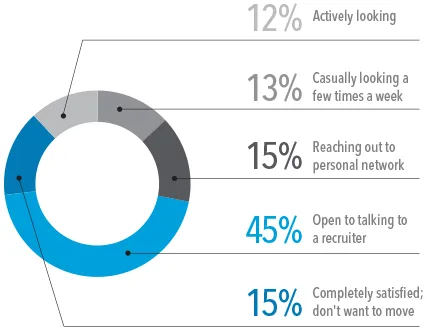Top 7 Best Recruitment Strategies For 2021

Recruitment strategies play a vital role in the success of your organization. 28% of workers say they’ve left a job in the first 90 days due to poor onboarding, unclear expectations and goals, and cessation of training after onboarding. What’s more, each open position costs an average of $500 per day. Needless to say, it’s critical to implement recruitment strategies to attract and retain talent.
Here we’ll discuss the top 7 hiring strategies you can implement today for a better recruitment process tomorrow.
Spiff Up That Career Page
A common place job seekers visit before applying to your company is your site’s career page. This can make or break a prospect’s decision to apply, so this page must be top-notch.
Make evident what culture is like at your company. Doing so can include statistics on diversity within the company, awards you’ve won, what your values are, and ways you’re supporting employees, such as paid vacation employee development, and more.
You can also add employee testimonials or chatbots to your careers page as part of your recruitment process. The KAI chatbot is one system you can use if you’re in finance.
Improve Employer Brand
Across the globe, 72% of leaders in recruitment note that employer branding significantly impacts hiring.
Although improving your employer brand is arguably the most critical change you could make that underlies all other recruitment strategies, it’s costly and timely to do.
However, employer branding pays off. A solid employer brand reduces cost per hire by 50% while reducing turnover by 28%.
General Electric (GE) is a prime example of the impact employer branding can have. The company launched TV commercials to help fill developer roles. This television campaign attracted 66% more applicants to the GE site. If TV commercials can help GE hire developers, employer branding can certainly help you!
Here are some strategies to help with employer branding:
- Be active on social media
- Show off your company and people (more on that later)
- Answer negative comments politely and timely
- Share knowledge and position yourself as an expert
- Make your work ethic and standards clear in actions, such as employee paid volunteer time or annual corporate donations
Share Culture On Social Media
Across the world, 3.78 billion people, or 48% of the population, use social media every day. Of these people, the average time per day spent on social media is 2.5 hours. It’s therefore likely that potential employees will check out your social media, and it may even encourage them to apply if they weren’t previously thinking about it.
Consider using Instagram as one of your recruitment strategies to attract and retain talent. Here you can feature employees and their journeys, post photos of employee development events, make clear what company values are, and interact with the community via stories.
Answer Candidate FAQs
One of your recruitment strategies can be answering candidate FAQs either on your careers page (highly recommended), on job postings, as part of follow-up emails, or anything in between.
Answering questions is a win-win as it helps reduce the hiring team’s workload. If candidates can get their most common questions answered elsewhere, they won’t need to contact your team.
Glossier did a fantastic job with these FAQs. Some questions you can answer as part of your recruitment strategy plan include:
- Are there internship roles at your company?
- Do you offer remote positions?
- How will I know a role has been filled?
- I don’t meet all the qualifications for a role. Should I bother applying?
- What does your hiring process look like?
- How much paid time off do you offer?
Innovate Your Hiring Process
Toggl made some innovative decisions as part of its many recruitment strategies. The company doesn’t use resumes but instead implements hiring tests which are favored by 91% of applicants.
As a result of hiring tests, Toggl saw a 50x increase in applications per open role and can automatically shortlist the top 10% of applicants for interviews.
First, think about pain points during your hiring process. What parts are cumbersome on your hiring team, and how do candidates feel about the process? If you aren’t sure, you can send out a short survey to gather feedback.
From there, try new ideas. These can include recruiting from a 100% remote talent pool for college students, contacting potential employees via social media, instituting an employee referral program, and more.
Don’t Neglect Passive Job Searchers
Did you know that passive candidates, or those who aren’t actively on the hunt for a job, make up 73% of candidates? Additionally, it’s estimated that 85% of employees would change jobs if a better opportunity arose.

While active talent is wonderful, the top candidates leave the job market quickly. Passive job searchers are hidden gems that can be found through referrals, LinkedIn, and anywhere else you can find candidates.
Remember that these types of candidates won’t be as prepared for the hiring process because, well, they aren’t looking. As part of your recruitment strategies, make it easy for these candidates to apply to decrease the barrier to entry.
Make Your Job Post Accurate
Have you ever heard the stories of companies posting a job requiring more years of experience with a particular technology than that technology has existed? Yikes. The recruitment process is a tricky one, but there’s no room for mistakes such as these.
To avoid looking careless and incompetent, proofread your job post many times. Verify that all information is accurate. Further, you’ll want to clearly describe the expectations for the role and the type of applicant you’re interested in. This can include relevant experience, schooling, and personality traits.
Of course, you want to hire the best talent possible. That doesn’t mean asking for someone with a Master’s and 10+ years of experience while offering an entry-level salary. Accuracy also means knowing the market and what applicants are worth; that’s part of great employer branding.
Conclusion
Now that you understand the importance of top-notch recruitment strategies, it’s time to get started.
If you’re looking to hire your next executive leader, Jennings Executive can help take the guesswork out of recruiting. With two decades of experience, our team knows how to find and place the best leadership talent at your company. Learn more today!
Recommended For You

The Hidden Burnout Risk In Pricing Roles
Pricing burnout is real: high conflict, low control—fix it with authority and systems.

Talent Benchmarking for Pricing Roles
Align pricing role scope, title & comp with real market benchmarks before hiring.

The Pricing Analyst's Toolkit
The essential pricing analyst toolkit—and what truly drives impact in the role.

Why Your Pricing Team Can't Be All Strategy Or All Execution
Pricing teams break when strategy and execution are out of balance—here’s how to fix it.

The Pricing Career Ladder - From Analyst To VP and Beyond
Inside the pricing career ladder: what drives growth from analyst to VP

What Makes A Great Pricing Leader
Great pricing leaders connect strategy to execution, influence without authority, and drive value.


